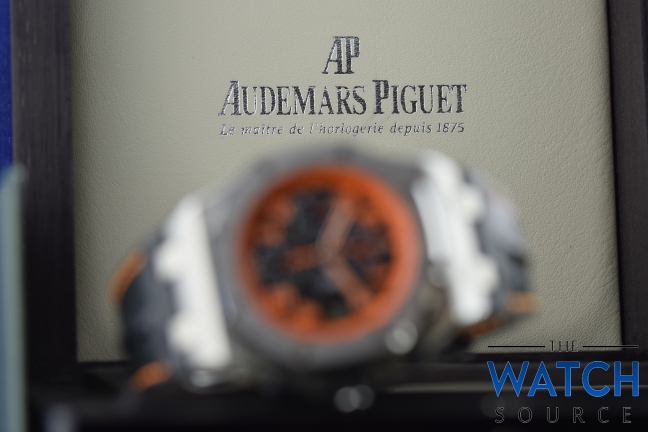We decided it was time to review something a bit more left field after the IWC and Rolex of the past weeks so we settled on this incredible Audemars Piguet Royal Oak Offshore Volcano (26170ST.OO.D101CR.01) that immediately stood out to us! This watch needs little introduction and there is a lot of hype surrounding Royal Oak Offshore models so we’ll take a look at just how unique this steel beast is!

HISTORY:
The BaselWorld (then called the Annual Swiss watch show) of April 1972 saw the birth of the Original Royal Oak from the struggling Audemars Piguet company. As with many, Audemars Piguet were hit hard by the invention of Quartz that many believed made the mechanical wrist watch obsolete due to its incredible accuracy and high tech nature of the invention when it came about in the early 1970s. The so called Quartz crisis took significant effect on the company, and without preventative action bankruptcy was becoming imminent. Picking up off potential market demands in Italy for a steel sports watch, the task for the design was given to the Proven Swiss designer Gerald Genta. with Audemars Piguet’s managing director Georges Golay giving Genta less than 24 hours to come up with a design. A design that Genta would later describe as the masterpiece of his career. Inspired by a classic Divers helmet the watch was a revolution at the time, with a unique octagonal bezel with 8 hexagonal screws prominently integrated into the slab sided bezel. The watch was finished immaculately and featured a dial with a never before seen petit tapisserie deisgn. The watch further stood out with its visible water resistance gasket and intricate integrated bracelet, and most of all, measuring in very thin at only 7mm tall, but very wide for the time at 39mm across. Initially the piece didn’t move well, first put on the market at 3300 Swiss Francs it was more expensive than a gold Patek-Phillipe and 10x the cost of Rolex Submariner! It Faced harsh scrutiny from critics and took over a year to sell the first 1000 pieces. It later saw its success, and helped rescue the company from bankruptcy on the verge of its centenary. The Royal Oak name, though doesn’t seem nautical at first impression, also has strong ties to the Ocean. The name coming from a series of eight Royal Navy warships, coinciding with the octagonal bezel. The ships themselves taking their name from the hollow Oak tree where king Charles II hid to escape the Parliamentarians after the battle of Worcester in 1651. The 20th anniversary of the Royal Oak saw the birth of the Royal Oak Offshore chronograph. Audemars Piguet wanted the inspiration for the piece to be the watch deconstructed. This showed in the large rubber gasket exposed beneath the bezel. At the time the 42mm sizing was very unusual and it was nicknamed ‘the Beast’! Many Royal Oak traditionalists were let down by the new design introduced at Baselworld 1993, including Gerald Genta who according to the Designer of the Offshore Emmanuel Gueit “invaded the booth shouting that his Royal Oak had been completely destroyed”! Despite this, The Offshore saw immediate commercial success and is still popular today.
CASE & BEZEL:
We have a lot to talk about here, as the casework of the Royal Oak Offshore is exceedingly fine, and there is a lot of it! Though the case is only 42mm wide its height at 14.3mm and large stainless steel bezel give it a definite presence on the wrist! With a straight grain brushed finish that flows vertically across the case from lug to lug, interrupted only by the thick chamfered edge of the bezel and polished Octagonal screw heads. This means the case captures light in the graining of the finish instead of reflecting it away like a case that is more polished would. The slight bevel to the case edges gives that occasional glint of light over the brushed case. The crown and crown guards further extend the dimensions of the case, offsetting the symmetry and extending the presence of the watch towards the hand. The crown and pushers have a rubber coating that gives good grip when in use, despite the lack of knurling on the screw down crown, instead maintaining the slab sided style with an octagonal crown, adorned with the Audemars Piguet branding on the crown face. The lugs are definitely unconventional ,just like the exposed gasket beneath the bezel, but is characteristic of the Royal Oak design, while still being comfortable. With the sharp pivot from the flat top of the middle case into the lugs, on the underside the metal wraps around the wrist, making it suitable for all wrist sizes.
DIAL & HANDS:
The dial texture has largely remained unchanged from the original Royal Oak, keeping the universally recognisable square pattern of the dial. However, the dial pattern has changed as with the rest of the watch, from a ‘Petit Tapisserie’ to a ‘Mega Tapisseire’ as the square structuring has increased significantly in size over the years. Similarly, the main handset has changed little in shape. Now however, filled with Orange luminescence along with the bold numerals that fill the empty spaces on the dial, living up to the ‘Volcano’ title being matched by the tachymeter marked orange rehort. The hands are constructed from white gold instead of steel, giving them a purer and cleaner appearance. The dial features an internally magnified date aperture at 3 O’clock meaning the watch is topped with a flat sapphire crystal. The numerals are thinly rimmed in either steel or white gold and have a very 3D appearance due to the sunk look of the lume infill. The Sub-dials are likewise lined in what appears to be steel or white gold and have a turned, radial texturing. The ‘AUDEMARS PIGUET’ branding and ‘AP’ logo are printed on a platform on the dial as to prevent the text being lost in the dial pattern.

MOVEMENT:
The first thing that struck me about this piece while observing it to write this report is the beat rate. The Audemars Piguet Calibre 3126 / 3840 manufacture has a beat rate of 21,600 V.P.H. Which to me, is a welcome change from the repeated 28,800 V.P.H most commonly found in modern Swiss watches. The more staccato sweep is an appealing, unique and characteristic feature, with a beat rate this slow generally found in vintage pieces. But, that does not at all mean it is without the modern technology behind the face that mirrors its modern construction: this 59 jewel movement features a screwed mobile stud balance spring holder with balance housing variable inertia blocks, a cam operated chronograph mechanism, a hacking balance and ceramic ball bearings in the oscillating rotor weight. It is a real shame Audemars Piguet didn’t equip the Royal Oak Offshore with an exhibition case back as there is plenty to be admired on the Calibre 3126 / 3840 manufacture movement. With a monobloc 22 carat gold rotor weight and inverted snailing on the bridges with diamond graved chamfered edges as well as a perlarged main plate
STRAP:
This piece features a hand stitched hornback black alligator strap. The orange accents of the strap compliment the dial colour and the hornback style strap isn’t commonly seen on many watches of any decade and suits the Offshore perfectly. The deployant clasp is also fascinating, with elongated steel ‘AP’ letters making up the folding limbs of the buckle and the clasp itself is understated and simple, branded with engraved Audemars Piguet text. The strap is malleable and not overly thick making the watch surprisingly comfortable to wear. I wasn’t expecting this watch to be very comfortable due to it having such a chunky solid case and presumably limited strap movement where the strap meets the case. But the pivoting strap mounting points makes it a delight to wear instead of a chore like some other watches with a less considerate case and strap design.
BOX:
The box for this watch is quite heavy! among heaviest of any watch box I have experienced, despite its relatively small dimensions, especially when compared to the box of a similarly priced Omega or Hublot. The box is clearly made of a dense and luxurious real wood which qualifies its heft. The box is relatively understated, with a minimalist interior featring only the watch and its cushion, with silver Audemars Piguet branding meeting you when the push button locking box is opened. With the documents and papers contained as part of the outer the box reserving the white leather lined inner box to be reserved for the watch only.

VERDICT:
We already knew we’d be impressed by this watch and it definitely doesn’t disappoint. The finish is only something that can be fully appreciated in person and the depth of the dial simply cannot be captured on photo. And the weight and heft behind this watch is just right to know you are wearing a better than average watch without being over weight causing crown bruises on your hand! Many see this piece as the perfect watch and now I have experienced it in person I can sympathise whole heartedly. This piece simply needs to be experienced in person for just a few moments and you will likely find yourself in agreeement!
If you want to be the next owner of this incredible watch, view it to buy at our Pre-Owned site https://www.thewatchsource.co.uk/preowned/ Or, as always, to simply enjoy this gorgeous piece, check out our extensive in-house photography of the piece in the gallery below.
Be sure to follow The Watch Source blog for instant email notifications when we publish new releases! Alternatively, like our Facebook, Instagram or Twitter to be the first to know about new releases and other updates from The Watch Source!
GALLERY:
references:
https://www.timeandwatches.com/p/history-of-audemars-piguet-royal-oak.html






















